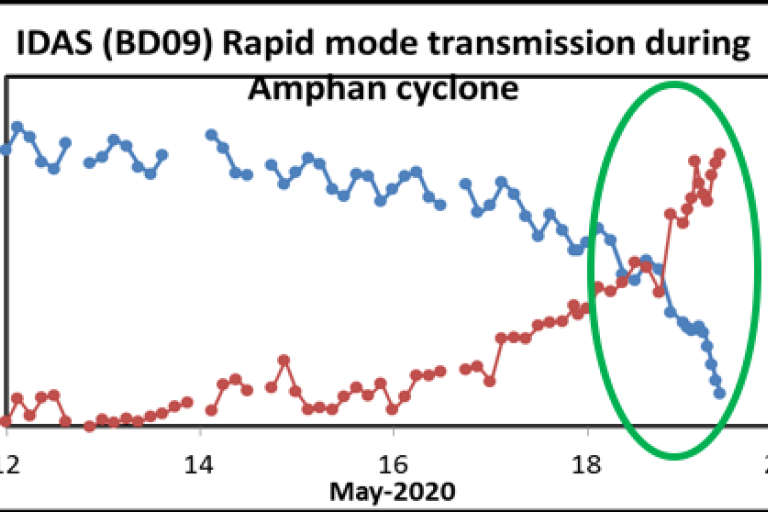Rapid mode data transmission by the MoES-NIOT Data buoy during the Cyclone Amphan in Bay of Bengal
Under the Ministry of Earth Sciences (MoES), Government of India, the Ocean Observations Systems group of National institute of Ocean Technology (NIOT), Chennai India established Moored buoy network in Indian Ocean in 1997. A new technique of auto-sensing low Air pressure and high wind speed leading to switch over to rapid mode data transmission is developed for which patent is applied. One of the Indian moored buoy system (WMO TD: 23092, at 17.5oN/ 89.1oE) deployed in Northern Bay of Bengal switched over to high frequency transmission mode during the passage of cyclone Amphan on 19th May 2020. A unique algorithm is implemented in this indigenous buoy system capable of transmitting real time data sets in high frequency mode during cyclone at low pressure and high wind speeds. This buoy system withstood the cyclone pass and also provided valuable Data sets which was disseminated in near real time to nodal agencies for accurate forecast and the land fall. Dr Rajeevan, Secretary MoES acknowledged the accurate forecasts and warnings for Cyclone Amphan by India Meteorology Department, which helped to save precious lives. He noticed buoy data showing strong stirring of water due to strong winds reduce SST a drop by 4 deg. Cyclone Amphan signal was most evident in NIOT-MoES Buoy BD13 (87E, 14 N) located at a distance of 74 km (40 nm) from the cyclone track. Sea level pressure dropped to 967 hPa and wind speed increased to 101 km/hr (28 m/s) on 18.05.2020 12 GMT. Buoy also recorded Significant Wave Height of 6 metres.

Under the Ministry of Earth Sciences (MoES), Government of India, the Ocean Observations Systems group of National institute of Ocean Technology (NIOT), Chennai India established Moored buoy network in Indian Ocean in 1997. A new technique of auto-sensing low Air pressure and high wind speed leading to switch over to rapid mode data transmission is developed for which patent is applied. One of the Indian moored buoy system (WMO TD: 23092, at 17.5oN/ 89.1oE) deployed in Northern Bay of Bengal switched over to high frequency transmission mode during the passage of cyclone Amphan on 19th May 2020. A unique algorithm is implemented in this indigenous buoy system capable of transmitting real time data sets in high frequency mode during cyclone at low pressure and high wind speeds. This buoy system withstood the cyclone pass and also provided valuable Data sets which was disseminated in near real time to nodal agencies for accurate forecast and the land fall. Dr Rajeevan, Secretary MoES acknowledged the accurate forecasts and warnings for Cyclone Amphan by India Meteorology Department, which helped to save precious lives. He noticed buoy data showing strong stirring of water due to strong winds reduce SST a drop by 4 deg. Cyclone Amphan signal was most evident in NIOT-MoES Buoy BD13 (87E, 14 N) located at a distance of 74 km (40 nm) from the cyclone track. Sea level pressure dropped to 967 hPa and wind speed increased to 101 km/hr (28 m/s) on 18.05.2020 12 GMT. Buoy also recorded Significant Wave Height of 6 metres.
- WMO Member:
- India

